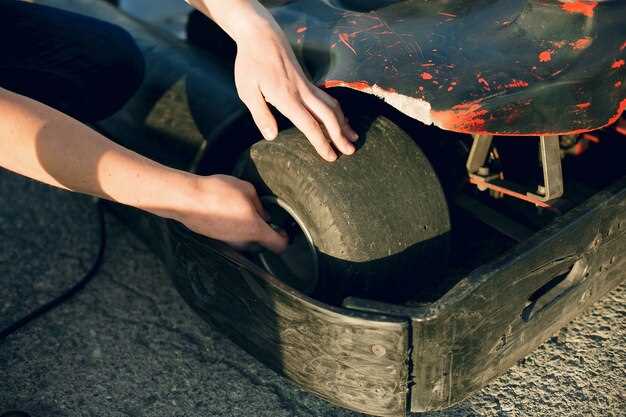
Proper maintenance of your All-Terrain Vehicle (ATV) is essential for ensuring its longevity and optimal performance. Regular upkeep not only enhances the riding experience but also safeguards your investment. Understanding the key components of maintenance can help you prevent costly repairs and extend the life of your ATV.
Whether you’re an occasional rider or a seasoned enthusiast, keeping your ATV in peak condition requires a systematic approach. Routine checks, timely oil changes, and tire maintenance are just a few aspects that contribute to the overall health of your vehicle. By incorporating these practices into your regular routine, you set the stage for a successful riding season.
In this article, we will explore essential maintenance tips and techniques tailored specifically for ATVs. From understanding the significance of each component to actionable steps you can take, we will help you maximize your ATV’s performance. Don’t underestimate the power of proactive care; it’s the difference between a reliable ride and a frustrating experience. Let’s get started on the path to a well-maintained ATV.
Regularly Check and Change the Oil
Maintaining your ATV’s oil is essential for ensuring its optimal performance and longevity. Regular oil checks and changes prevent engine wear, enhance efficiency, and result in smoother rides. Follow these guidelines to keep your ATV running at peak performance.
Here’s why regular oil changes are crucial:
- Lubrication: Oil lubricates engine components, reducing friction and wear.
- Cooling: Fresh oil helps disperse heat generated during operation, preventing overheating.
- Contaminant Removal: Old oil accumulates dirt and debris, which can lead to engine damage.
- Efficiency: Clean oil improves fuel economy and overall engine efficiency.
Follow these steps for checking and changing your ATV’s oil:
- Gather Necessary Tools: You will need an oil wrench, a funnel, an oil catch pan, and the correct type of oil for your ATV.
- Check Oil Level: Start your ATV and let it run for a few minutes, then turn it off and wait to allow the oil to settle. Remove the dipstick, wipe it clean, reinsert, and check the level. If it’s low, top it off with fresh oil.
- Change Oil: If the oil appears dark and gritty, it’s time for a change. Position the oil catch pan under the ATV, remove the oil drain plug, and let the old oil drain completely.
- Replace Oil Filter: Change the oil filter as per the manufacturer’s instructions. This will ensure optimal filtration of contaminants.
- Add New Oil: Insert the drain plug back and refill the engine with new oil using the funnel. Refer to your ATV’s manual for the correct oil type and volume.
- Check for Leaks: After changing the oil, start the ATV and inspect for any leaks around the drain plug or filter.
Establish a regular schedule for oil checks based on your usage frequency and manufacturer’s recommendations, typically every 20 to 50 hours of operation. Keeping your ATV’s oil fresh and clean will ensure robust engine health and enhance your riding experience.
Inspect and Replace Air Filters as Needed
Regular inspection and replacement of air filters are crucial for maintaining optimal performance of your ATV. Air filters prevent dirt, dust, and debris from entering the engine, ensuring that only clean air is mixed with fuel for combustion. A clogged or dirty air filter can restrict airflow, leading to a decrease in power, fuel efficiency, and overall engine performance.
Set a schedule to inspect your air filters regularly, typically at every 50 to 100 hours of operation, or as recommended in your ATV’s owner manual. Environmental conditions, such as riding in dusty or muddy areas, may necessitate more frequent checks.
When inspecting the air filter, look for the following signs of wear or contamination:
| Condition | Action |
|---|---|
| Visible dirt or debris | Replace the air filter |
| Discoloration or excessive wear | Replace the air filter |
| Physical damage (tears or holes) | Replace the air filter |
| Normal condition (clean and intact) | Reinstall after cleaning, if reusable |
If the air filter is reusable, clean it according to the manufacturer’s instructions using compressed air or a specialized cleaner. Ensure it is completely dry before reinsertion. If the filter is not reusable or shows signs of significant wear, replace it with a new one that meets the OEM specifications for your ATV model.
Taking the time to properly inspect and replace air filters will not only enhance your ATV’s performance but also prolong the life of the engine, ensuring an enjoyable riding experience.
Monitor Tire Pressure and Tread Depth
Proper tire pressure and tread depth are critical to the performance, safety, and lifespan of your ATV. Regularly checking and maintaining these aspects can enhance traction, fuel efficiency, and overall handling.
Firstly, tire pressure should be checked before each ride. Under-inflated tires can lead to poor handling, increased tire wear, and a higher risk of punctures. Conversely, over-inflated tires can result in a harsh ride and reduced contact with the ground. Refer to the manufacturer’s specifications for the recommended tire pressure, which is typically found in the owner’s manual or on a label located on the ATV itself.
Use a reliable tire pressure gauge to get an accurate reading. If adjustments are needed, use an air compressor to inflate the tires to the recommended pressure. Always check the pressure when the tires are cold, as heat from riding can cause air expansion and yield inaccurate readings.
In addition to monitoring tire pressure, regularly inspecting tread depth is essential. Tread depth affects the ATV’s ability to grip various surfaces, especially slippery or uneven terrain. Insufficient tread can compromise safety and performance. Use a tread depth gauge or the penny test; insert a penny into the tread with Lincoln’s head facing down. If you can see all of Lincoln’s head, it’s time to replace your tires.
Regularly inspect your tires for signs of wear, cracks, or punctures, as these can compromise their integrity. Keeping your ATV’s tires in optimal condition will not only enhance performance but also ensure a safer riding experience.
Examine the Battery and Electrical System
The battery and electrical system of your ATV play a crucial role in its overall performance and reliability. Regular examination of these components is essential to prevent unexpected failures during outings.
Start with the Battery: Inspect the battery for any signs of corrosion on the terminals, which could lead to poor connections. Clean the terminals using a mixture of baking soda and water if necessary. Ensure that the battery is securely mounted and check for any cracks or leaks in the casing.
Test the Battery Voltage: A multimeter can help you gauge the battery voltage. A healthy, fully charged battery should read around 12.6 volts or higher. If the voltage is significantly lower, recharge the battery or consider a replacement.
Check the Fluid Levels: If your battery is not sealed, check the electrolyte levels in the cells. Add distilled water to maintain the proper levels if necessary, but avoid overfilling.
Inspect the Electrical Connections: Examine all wiring and connections for signs of wear or damage. Loose or frayed wires can cause electrical failures. Tighten any loose connections and replace any damaged wires promptly to maintain safety and functionality.
Look at the Charging System: Ensure that the alternator and regulator are functioning correctly. A faulty charging system can lead to battery drain. Test the system while the engine is running – the voltage should increase to around 13.5 to 14.5 volts, indicating proper functioning.
Evaluate the Fuses: Check the fuse panel for any blown fuses. Replacing blown fuses is a quick fix that can resolve electrical issues. Always use fuses with the correct amperage to avoid further complications.
Routine checks of your ATV’s battery and electrical system not only enhance reliability but also promote longevity. Addressing any issues promptly will ensure that your machine performs at its best on every adventure.
Keep the Chassis Clean and Free of Debris

The chassis of your ATV is crucial for its overall performance and stability. A clean chassis ensures that all components work efficiently and reduces the risk of malfunctions. Dirt, mud, and debris can accumulate, leading to wear and tear, which ultimately affects the handling and safety of your vehicle.
Regular cleaning is essential, especially after off-road excursions where mud and debris are prevalent. Use a hose to wash off any loose dirt and mud, taking care to apply pressure without risking damage to sensitive parts. A soft brush can help dislodge stubborn debris from tight spaces.
Inspect the chassis thoroughly for any signs of corrosion, rust, or damage. Pay close attention to areas where dirt tends to accumulate, such as suspension components and undercarriage. Promptly addressing these issues can prevent more significant problems down the road.
Incorporating a periodic maintenance schedule will keep your chassis in top condition. During each cleaning session, apply a suitable lubricant to joints and moving parts to prevent rust and ensure smooth operation. Keeping the chassis clean and free of debris isn’t just about appearance; it’s vital for the reliability and longevity of your ATV.
Finally, store your ATV in a clean environment whenever possible. Covering it can prevent dust accumulation and protect it from the elements. By maintaining a clean chassis, you enhance your ATV’s performance and safety, ensuring an enjoyable riding experience.
Schedule Routine Inspections and Tune-Ups
Maintaining your ATV in optimal condition requires a commitment to regular inspections and tune-ups. These practices help identify potential issues before they escalate, ensuring your vehicle performs efficiently and safely.
Establishing a routine schedule is essential. Here are key steps to consider:
- Set a Regular Interval: Determine how often you will conduct inspections. Common intervals are:
- Every 10 hours of operation
- Monthly for seasonal usage
- At least twice a year for year-round riders
- Create a Checklist: An inspection checklist can help you stay organized. Include the following items:
- Fluid levels (oil, coolant, brake fluid)
- Tire pressure and tread wear
- Brake functionality
- Chain and belt condition
- Battery health and connections
- Lights and electrical systems
- Suspension and frame integrity
- Air filter cleanliness
- Fuel system checks
- Perform Tune-Ups: Regular tune-ups are crucial for peak performance. Suggested maintenance actions include:
- Changing the oil and oil filter
- Replacing worn spark plugs
- Adjusting the carburetor or fuel injection system
- Lubricating mechanical parts
- Inspecting and replacing the air filter
- Document Findings: Keep written records of inspections and tune-ups. This documentation helps track maintenance history and can identify recurring issues.
- Consult Professional Help: If you encounter problems beyond your expertise, seek assistance from a qualified technician. Their expertise can provide solutions that ensure longevity and performance.
By systematically scheduling routine inspections and tune-ups, you ensure your ATV remains dependable, allowing for safe and enjoyable rides. Prioritizing maintenance will ultimately extend the life of your vehicle and enhance your overall riding experience.

